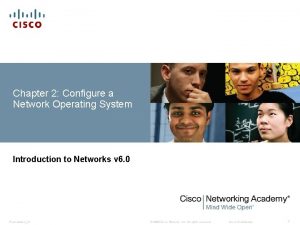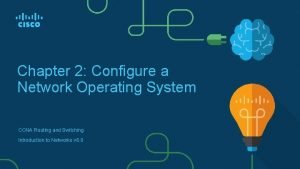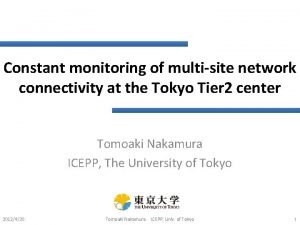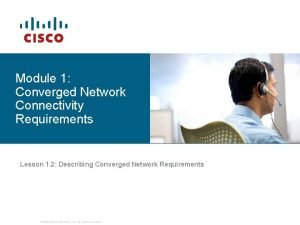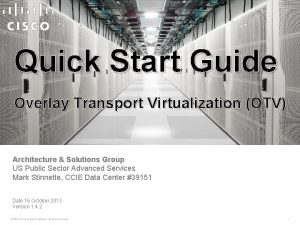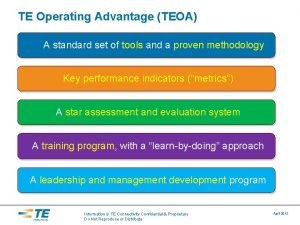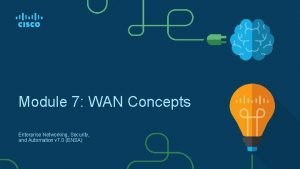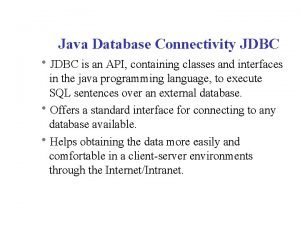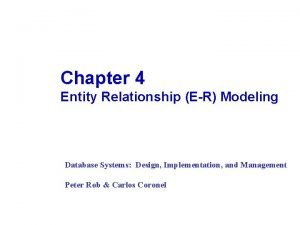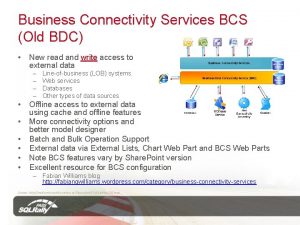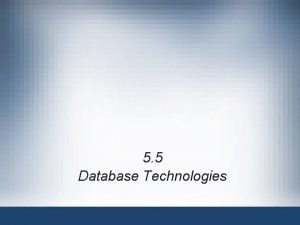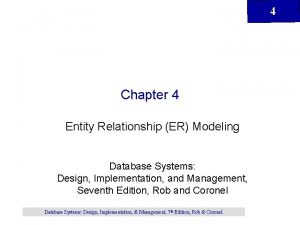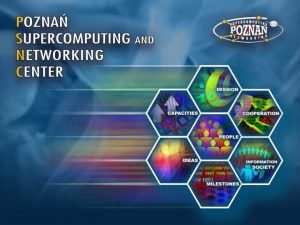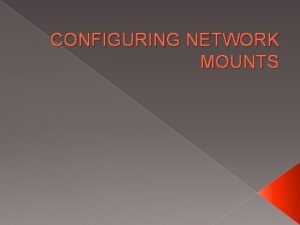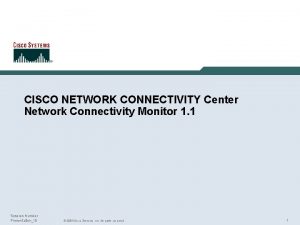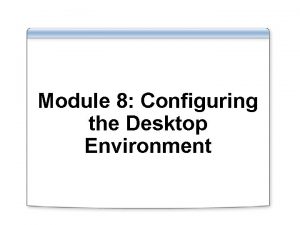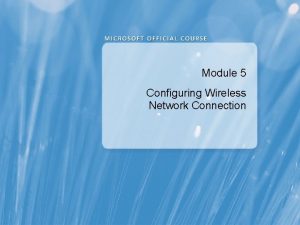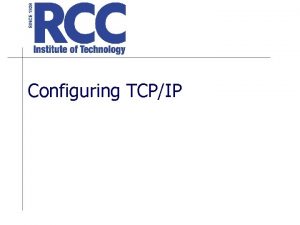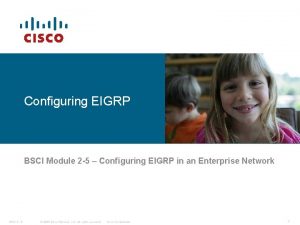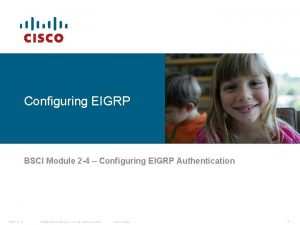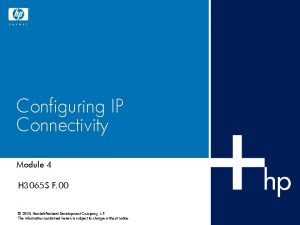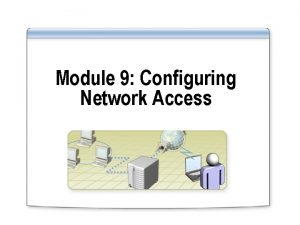Module 4 Configuring Network Connectivity Module Overview Configuring





























- Slides: 29

Module 4 Configuring Network Connectivity

Module Overview • Configuring IPv 4 Network Connectivity • Configuring IPv 6 Network Connectivity • Implementing Automatic IP Address Allocation • Troubleshooting Network Issues

Lesson 1: Configuring IPv 4 Network Connectivity • What is an IPv 4 Address? • What is a Subnet Mask? • What is a Default Gateway? • What are Public and Private IPv 4 Addresses? • Demonstration: Configuring an IPv 4 Address • Types of Computer Names • Methods for Resolving Computer Names

What is an IPv 4 Address? 1 to other An IPv 4 address identifies. Subnet a computer IP Address 192. 168. 2. 180 computers on a network. IP Address 192. 168. 2. 181 IP Address 192. 168. 2. 182 IP Address 192. 168. 1. 200 Dotted decimal representation IP Address of the 192. 168. 1. 201 address Subnet 2 IP Address 192. 168. 1. 202

What is a Subnet Mask? And here is the host ID the fourth octet. Note network ID for this number. This isisa the simple Class Cin type IPv 4 number, see AHere subnet mask specifies which part of an This IPv 4 that this host ID is shared 1 of 254 hosts onhosts this specific network ID will be by all the on the how 3 octets (255, 255) are for the network address is the network ID and which part of the subnet ID and. IPv 4 onlyaddress 1 same octet (0) is for the host ID is the host ID. IP address 192 w Subnet mask 255 w Network ID 192 w 168 x 255 x 168 x 1 200 y 255 z 0 y 1 y z 0 z

What is a Default Gateway? A default gateway is a device, usually a router, on Use a default gateway the internal routing to a TCP/IP internet thatwhen forwards IP packets table on the other host has no information about subnets. the destination subnet. Windows 7 clients Default gateway Subnet 1 Subnet 2 Router

What are Public and Private IPv 4 Addresses? Public • Required by devices and hosts that connect directly to the Internet • Must be unique • Routable on the Internet • Must be assigned by IANA Private • Non-routable on the Internet • Can be locally assigned by organization • Must be translated to access the Internet

Demonstration: Configuring an IPv 4 Address Your instructor will demonstrate how to configure a Windows 7 computer with: • An IPv 4 address • A subnet mask • A default gateway 10 min

Types of Computer Names Name Description • Up to 255 characters in length • Can contain alphabetic and numeric characters, periods, and hyphens Host name • Part of FQDN • Represent a single computer or group of computers • 15 characters used for the name • 16 th character identifies service Net. BIOS name • Flat namespace

Methods for Resolving Computer Names Domain Name System (DNS) 1 Local Host Name ü DNS is a service that manages the resolution of host names to IP addresses 7 LMHOSTS File ü DNS is the name resolution tool of choice for Windows 7 2 DNS Resolver Cache 6 Broadcast Windows Internet Naming Service (WINS) ü WINS is retained for backward compatibility Server WINS Server 3 DNS The Global Domain Names feature can remove 5 the ü need for WINS name server used to resolve Name Cache 4 Net. BIOS ü WINS is a Net. BIOS

Lesson 2: Configuring IPv 6 Network Connectivity • Benefits of Using IPv 6 • Windows 7 Support for IPv 6 • What is the IPv 6 Address Space? • IPv 6 Address Types • Demonstration: Configuring an IPv 6 Address

Benefits of Using IPv 6 Benefits of using IPv 6 compared to IPv 4 ü Larger address space ü More efficient routing ü Simpler host configuration ü Built-in security ü Better prioritized delivery support ü Redesigned headers

Windows 7 Support for IPv 6 is Enabled by Default Windows 7 uses IPv 6 by default to support security needs and additional features Windows 7 Dual Stack Windows 7 facilitates the dual stack to use IPv 4 and IPv 6 simultaneously Direct Access requires IPv 6 Windows 7 clients can use Direct Access which facilitates client computers connecting to the enterprise domain IPv 6 uses Remote Desktop IPv 6 supports Windows 7 File Sharing Security and Echo System features such as Remote Access and Direct Access

What is the IPv 6 Address Space? The IPv 6 address space: • Uses 128 bits as compared to 32 -bits that the IPv 4 address space uses • Allocates 64 -bits for the network ID and 64 -bits for the host ID • Uses a prefix to define the network ID IPv 6 uses hexidecimal notation Shorten 2001: 0 DB 8: 0000: 02 AA: 00 FF: FE 28: 9 C 5 A/64 Each digit represents four bits 2001: DB 8: 0: 0: 2 AA: FF: FE 28: 9 C 5 A/64 Shorten the address by dropping leading zeros and using zero compression 2001: DB 8: : 2 AA: FF: FE 28: 9 C 5 A/64 Continue shortening the address by The prefix is a forward slashdropping followed contiguous by groups of zeros the number of bits in the network ID

IPv 6 Address Types • Unicast – use for one-to-one communication between hosts • Multicast – use for one-to-many communication between computers that are defined as using the same multicast address • Anycast – use for locating services or the nearest router IPv 6 Unicast Address Types • Global Unicast – globally routable and reachable on the IPv 6 portion of the Internet • Link-Local – use when communicating with neighboring hosts on the same link • Unique Local Unicast – equivalent to IPv 4 private address spaces, such as 10. 0/8, and have the prefix FD 00: : /8

Demonstration: Configuring an IPv 6 Address Your instructor will demonstrate how to: • Manually configure a Windows 7 computer with an IPv 6 address • Verify the IP configuration 10 min

Lesson 3: Implementing Automatic IP Address Allocation • Automatic IPv 4 Configuration Process • Automatic IPv 6 Configuration Process • Demonstration: Configuring a Computer to Obtain an IPv 4 Address Dynamically • Troubleshooting Client-Side DHCP Issues

Automatic IPv 4 Configuration Process Static Configuration IPv 6 Client ü Assigns IP addresses on the 169. 254. 0. 0/16 ü network ü Cannot be used with: • Active Directory • Internet connectivity • Multiple subnets DNS IPv 4 • Client IPv 6 Router or WINS servers DHCP Server with IPv 4 Scope and IPv 6 Site Local Scope

Automatic IPv 6 Configuration Process Static Configuration IPv 6 Client DHCP v 6 Server with IPv 6 Scope and IPv 6 Site Local Scope IPv 6 Client IPv 6 Router

Demonstration: Configuring a Computer to Obtain an IPv 4 Address Dynamically Your instructor will demonstrate how to: • Automatically configure a Windows 7 computer with an IPv 4 address • Verify the IP configuration 10 min

Troubleshooting Client-Side DHCP Issues IPConfig is used to display IP configuration information and to release and renew addresses Option /all Description Displays all IP address configuration information /release Releases a dynamic IPv 4 address lease /renew Renews a dynamic IPv 4 address lease

Lesson 4: Troubleshooting Network Issues • Tools for Troubleshooting Networks • Process for Troubleshooting Networks • Demonstration: Troubleshooting Common Network- Related Problems

Tools for Troubleshooting Networks Tool Purpose Event Viewer Enables you to view errors relating to network activity Windows Network Diagnostics Helps to diagnose and resolve network problems IPCONFIG Displays IP configuration information and controls the DNS resolver cache PING and Path. PING Verifies basic IP connectivity TRACERT Verifies a routing path NSLOOKUP Enables testing of name resolution

Process for Troubleshooting Networks Windows Network Diagnostics IPConfig NSlookup Tracert Ping

Demonstration: How to Troubleshoot Network. Related Problems Your instructor will demonstrate how to use the TCP/IP troubleshooting tools to help resolve common connectivity problems. 10 min

Lab: Configuring Network Connectivity • Exercise 1: Configuring IPv 4 Addressing • Exercise 2: Configuring IPv 6 Addressing • Exercise 3: Troubleshooting Network Connectivity Logon information Virtual machine 6292 A-NYC-DC 1, 62924 A-NYC-SVR 1 User name ContosoAdministrator Password Pa$$w 0 rd Estimated time: 40 minutes

Lab Scenario • Laptop computers are being introduces for some of the managers in Contoso Corporation. You need to test how the IPv 4 configuration will behave when they are out of the office and a DHCP server is unavailable. • Contoso Corporation is considering the implementation of IPv 6 in the internal network. However, noone in the organization has much experience with IPv 6. You are performing some configuration tests with DHCPv 6 to see how it behaves. • A work experience student has been unsuccessful in attempting to resolve an network connectivity problem on a Windows 7 computer. The changes made to the computer have not been documented. You need to restore network connectivity for the computer.

Lab Review • How are APIPA addresses for IPv 4 similar to link-local addresses in IPv 6? • How can you update a Windows 7 computer to use the correct information after a host record is updated in DNS, but the Windows 7 computer is still resolving the name to the previous IP address?

Module Review and Takeaways • Review Questions • Tools
 Configure a network operating system
Configure a network operating system Configure a network operating system
Configure a network operating system Multisite network monitoring
Multisite network monitoring Network connectivity requirements
Network connectivity requirements Parse's theory
Parse's theory Overlay transport virtualization ppt
Overlay transport virtualization ppt Dansguardian https
Dansguardian https Packet tracer configuring multiarea ospfv2
Packet tracer configuring multiarea ospfv2 Gsm lecture
Gsm lecture Reflexive connectivity
Reflexive connectivity Teoa tools
Teoa tools Public connectivity
Public connectivity Rajnet
Rajnet Wan connectivity options
Wan connectivity options Java database connectivity api
Java database connectivity api Edge connectivity
Edge connectivity Ecfps
Ecfps Adjacency in digital image processing
Adjacency in digital image processing Design principles for web connectivity in iot
Design principles for web connectivity in iot What is multivalued attribute in er diagram
What is multivalued attribute in er diagram California essential habitat connectivity project
California essential habitat connectivity project Connectivity services orlando
Connectivity services orlando Connectivity package bmw
Connectivity package bmw Database connectivity technologies
Database connectivity technologies Bridge entity erd
Bridge entity erd What is business connectivity services add in
What is business connectivity services add in Peer reflexive candidate
Peer reflexive candidate Junos space connectivity services director
Junos space connectivity services director Vertex connectivity
Vertex connectivity Connectivity fault management
Connectivity fault management
